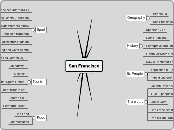8.4 Moving About
Contextual Outline
Increased access to transport is a feature of today’s society. Most people access some form of transport for travel to and from school or work and for leisure outings at weekends or on holidays. When describing journeys that they may have taken in buses or trains, they usually do so in terms of time or their starting point and their destination. When describing trips they may have taken in planes or cars, they normally use the time it takes, distance covered or the speed of the vehicle as their reference points. While distance, time and speed are fundamental to the understanding of kinematics and dynamics, very few people consider a trip in terms of energy, force or the momentum associated with the vehicle, even at low or moderate speeds.
The faster a vehicle is travelling, the further it will go before it is able to stop when subject to a constant retarding force. Major damage can be done to other vehicles and to the human body in collisions, even at low speeds. This is because during a collision some or all of the vehicle’s kinetic energy is dissipated through the vehicle and the object with which it collides. Further, the materials from which vehicles are constructed do not deform or bend as easily as the human body. Technological advances and systematic study of vehicle crashes have increased understanding of the interactions involved, the potential resultant damage and possible ways of reducing the effects of collisions. There are many safety devices now installed in or on vehicles, including seat belts and air bags. Modern road design takes into account ways in which vehicles can be forced to reduce their speed.
This module increases students’ understanding of the nature and practice of physics and the implications of physics for society and the environment.
skills
Sum p = const
p=mv
Ke =1/2mv^2
W=Fd
N2
N1
time dispacement- time velocity Graph
Distance and Displacement
Calcuate Velocity
Course
Safety
Momentum Exchange
Energy and Motion
Main Ideas
KE = 1/2mv^2
Work = Fs
Forces and motion
Main Ideas
Vectors and relative velocities
Newton 2 Net force creates acceleration
Centripetal Force
Velocity
Journey have varing instanteous velocity, and average velocity.
Velocity is a vector
How to measure velocity
Distance and Velocity versu time graphs.
Pracs
Varying velocity
Dispacement and velocity vs time graph
Analysis of Instaneious Velocity
Syllabus









